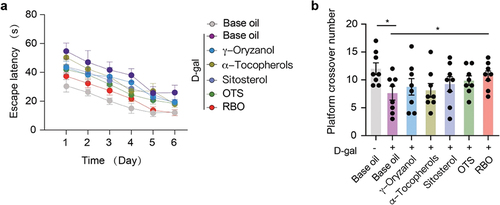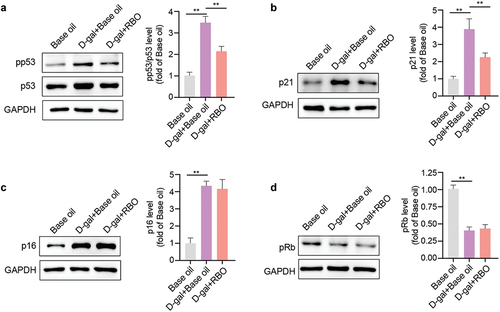Figures & data
Figure 1. Antioxidant capacity of RBO and its active ingredients. (a) antioxidation stability of different samples by Rancimat test at 100°C, 110°C and 120°C. (b) DPPH radical scavenging activity of different samples. (c) Reducing capacity of different samples (10 mg/mL). (d) Reducing capacity of base oil, γ-oryzanol, α-tocopherol, sitosterol, OTS, and RBO at different concentration. All data are presented as Mean ± SEM, (n = 3, 3 independent experiments with 2 technical replicates). *P < .05, **P < .01, ***P < .001. RBO: rice bran oil, OTS: γ-oryzanol plus α-tocopherol and sitosterol.

Figure 2. RBO can effectively scavenge oxygen free radicals. (a) Fluorescence images of DCF-DA stained HEK293T cells with indicated treatment after simulated with 2 mM H2O2., Scale bar = 50 µm. (b) DCF-DA fluorescence in HEK293T cells with indicated treatment after simulated with 2 mM H2O2. All data are presented as Mean ± SEM, (n = 3, 3 independent experiments with 3 technical replicates). *P < .05, **P < .01, ***P < .001. RBO: rice bran oil, OTS: γ-oryzanol plus α-tocopherol and sitosterol.

Table 1. The antioxidation stability of different samples by Rancimat test at 100°C, 110°C and 120°C.
Table 2. The reducing capacity of base oil, γ-oryzanol, α-tocopherol, sitosterol, OTS, and RBO at different concentration.
Figure 3. RBO improves antioxidant status in D-gal-induced senescence mice. (a) Changes in body mass in mice after indicated treatment of D-gal injured mice. Organ Index of thymus (b) and spleen (c) in D-gal injured mice after indicated treatment. Levels of SOD (d), MDA (e) and GSH-Px (f) in serum in D-gal mice. All data are presented as Mean ± SEM, (n = 8). *P < .05, **P < .01, ***P < .001. RBO: rice bran oil, OTS: γ-oryzanol plus α-tocopherol and sitosterol.

Figure 4. RBO attenuates D-gal induced inflammation in mice. The level of IL-2 (a), IL-4 (b), TGF-β (c), and IL-8 (d) in serum of senescence mice after indicated treatment. All data are presented as Mean ± SEM, (n = 8). *P < .05, **P < .01, ***P < .001. RBO: rice bran oil, OTS: γ-oryzanol plus α-tocopherol and sitosterol.

Figure 5. RBO alleviates learning and memory impairment of D-gal exposed mice. (a) the escape latency of the mice during MWM training. (b) the number of platform crossing of the mice during MWM training. All data are presented as Mean ± SEM, (n = 8). *P < .05. RBO: rice bran oil, OTS: γ-oryzanol plus α-tocopherol and sitosterol.

Table 3. The escape latency of the mice during MWM training.
Figure 6. RBO inhibits p53/p21 pathway in D-gal exposed mice. The protein level of pp53/p53 (a), p21 (b), p16 (c), and pRb in liver of D-gal injured mice were detected using western blot after RBO treatment. All data are presented as Mean ± SEM, (n = 8). *P < .05, **P < .01, ***P < .001. RBO: rice bran oil.

